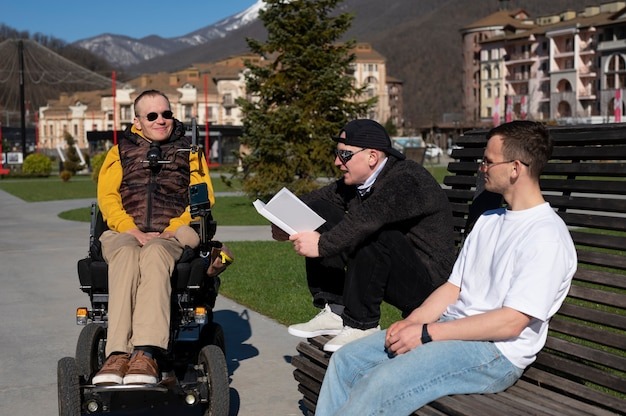Exploring new places, immersing oneself in other cultures, and making lifelong memories are all made possible by travel, which is a rewarding experience. Nevertheless, negotiating the intricacies of travel might provide particular difficulties for those who have impairments. Every facet of the trip, including lodging, sightseeing, and transportation, needs to be carefully planned to guarantee comfort and accessibility. We’ll go over crucial advice and methods in this in-depth guide to enable people with disabilities to go on rewarding and pleasurable vacation experiences.

1. Planning Ahead: The Key to a Smooth Journey:
The foundation of a successful accessible travel experience lies in meticulous planning. Start by researching destinations that prioritize accessibility and offer facilities tailored to diverse needs. Utilize online resources, such as travel forums and review platforms, to gather firsthand insights from fellow travelers with disabilities. Contact airlines, hotels, and tour operators in advance to inquire about accessible facilities and accommodations. By planning ahead, you can mitigate potential obstacles and enjoy a seamless travel experience from start to finish.
2. Choosing the Right Accommodation:
Selecting suitable accommodation is crucial for ensuring comfort and convenience during your travel tips. Look for hotels, resorts, or vacation rentals that offer accessible rooms equipped with features such as wheelchair ramps, grab bars, and roll-in showers. Verify the accessibility of common areas, including restaurants, pools, and fitness centers, to ensure unrestricted mobility throughout your stay. Additionally, communicate your specific requirements with the accommodation staff to guarantee a personalized and hassle-free experience.
3. Navigating Transportation with Ease:
Transportation plays a vital role in facilitating accessible travel, enabling individuals to explore diverse destinations with ease. When booking flights, opt for airlines that prioritize accessibility and offer assistance services for passengers with disabilities. Notify the airline of any special requirements, such as wheelchair assistance or mobility aids, to ensure a smooth boarding process. Similarly, research local transportation options at your destination, such as accessible taxis or public transit services, to facilitate seamless mobility during your stay.
4. Packing Essentials: Accessibility on the Go:
Packing strategically can enhance accessibility and comfort throughout your journey. Prioritize essential items such as medication, mobility aids, and assistive devices to ensure uninterrupted access to necessary resources. Consider investing in portable ramps, travel-sized accessibility aids, and compact mobility scooters to enhance mobility and independence during sightseeing excursions. Pack clothing and accessories suitable for varying weather conditions and cultural norms, allowing you to adapt seamlessly to different environments.
5. Exploring Destinations Responsibly:
Embarking on accessible travel tips adventures offers opportunities to explore diverse destinations and immerse yourself in unique cultures. Research attractions and landmarks that prioritize accessibility, such as museums, parks, and historical sites with wheelchair-friendly pathways and inclusive exhibits. Take advantage of guided tours and audio guides equipped with accessibility features, allowing you to experience the destination’s highlights with ease. Respect local customs and regulations while exploring, ensuring a positive and respectful interaction with the community.
6. Advocating for Accessibility:
As ambassadors of accessible travel, individuals with disabilities play a crucial role in advocating for inclusive practices and accommodations worldwide. Provide feedback to travel providers, businesses, and government agencies regarding accessibility challenges and opportunities for improvement. Share your travel experiences and insights through social media, blogs, or community forums to inspire and empower fellow travelers with disabilities. By amplifying your voice and advocating for change, you contribute to creating a more inclusive and welcoming travel environment for future generations.
7. Embracing the Journey: Building Lasting Memories:
Accessible travel is not just about reaching destinations; it’s about embracing the journey and creating meaningful memories along the way. Embrace the opportunity to connect with fellow travelers, locals, and communities, fostering mutual understanding and appreciation. Celebrate achievements and milestones during your travels, whether it’s conquering a new destination or overcoming accessibility barriers with resilience and determination. Cherish the moments of joy, discovery, and empowerment, knowing that every journey contributes to a more inclusive and accessible world for all.
Conclusion:
To sum up, accessible travel tips gives people with disabilities the chance to see the world, extend their perspectives, and have life-changing experiences. Through heeding these easily accessible travel advice and embracing the spirit of adventure, people can confidently and independently set out on rewarding travel adventures. One voyage at a time, let’s work to ensure that everyone has the chance to experience the beauty and diversity of our globe by making travel accessible to all.





2 Replies to “Accessible Travel Tips for People with Disabilities”
Comments are closed.